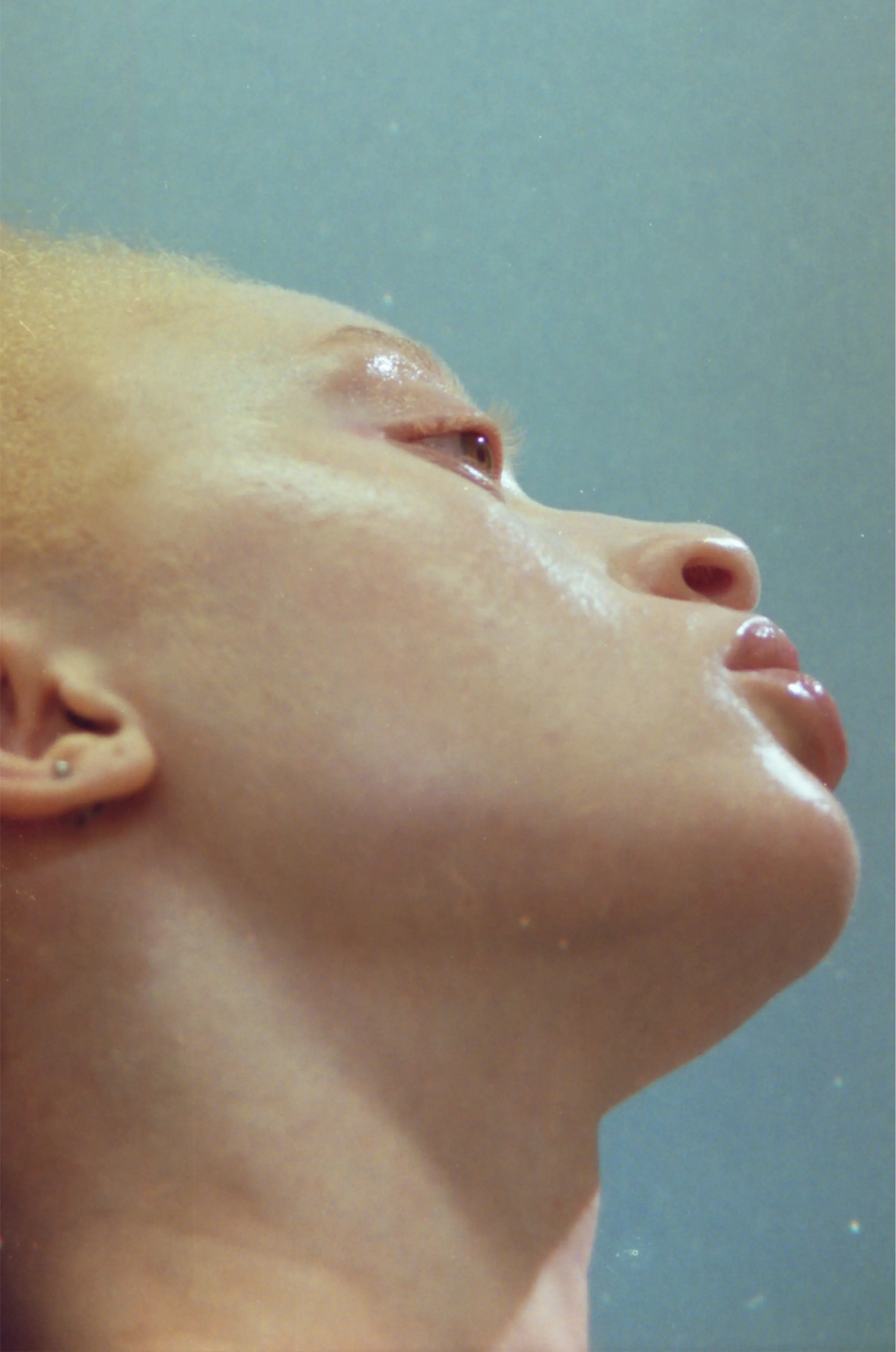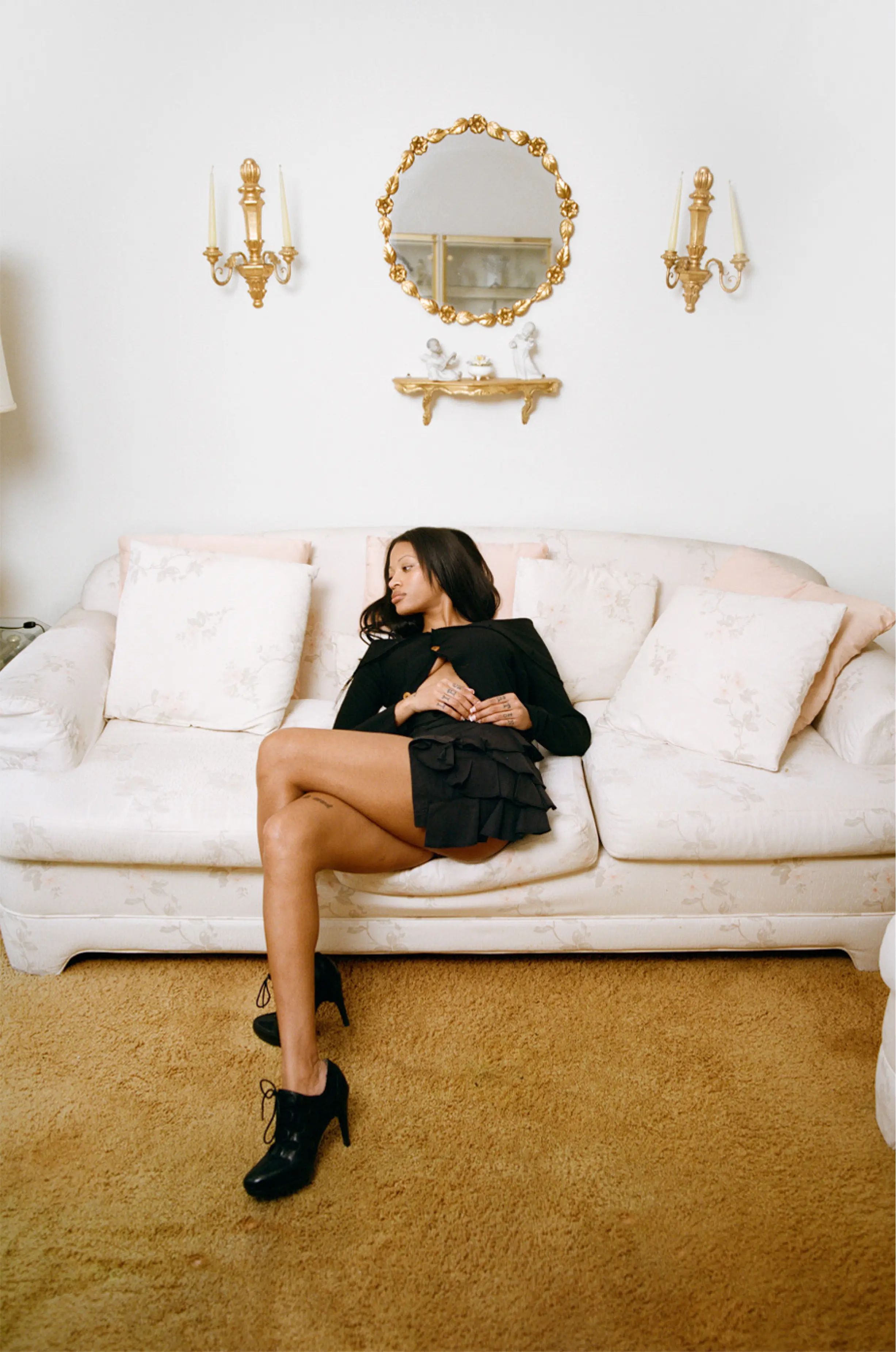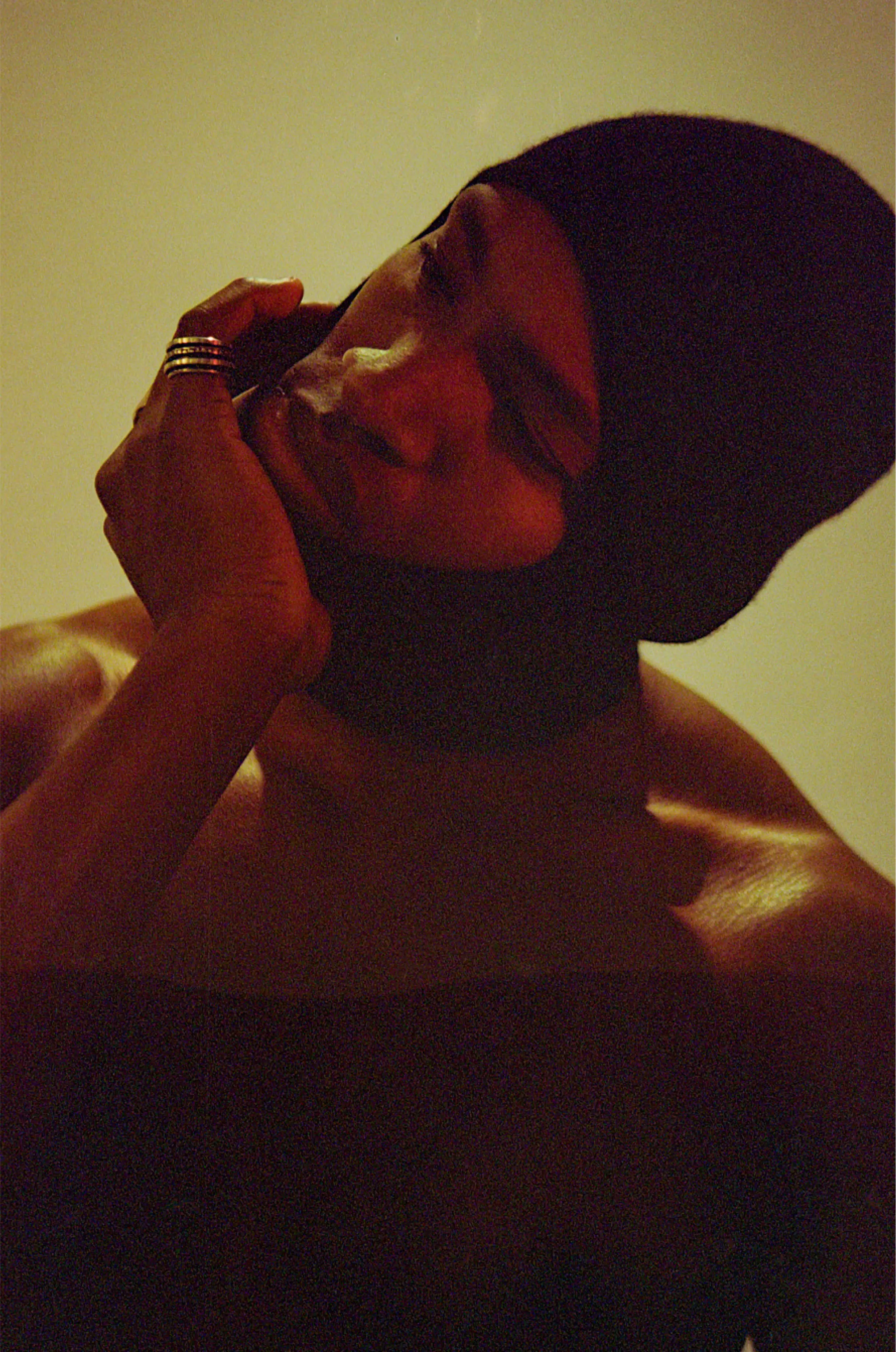Othello Grey is known for his ability to distill nuance into imagery, seamlessly weaving together the worlds of editorial and commercial photography. Through his work, he aims to peel back the layers of constructed beauty and challenge the ingrained biases that shape how Blackness is perceived. At the heart of his practice is a personal mission: to become the kind of creative reference he longed for growing up.
What are two images that you keep coming back to for inspiration?
⎯⎯⎯ The cover of Wolfgang Tillmans’s : Manual, and Fumiko Imano’s photos for the ASICS X Kiko Kostadinov Gesserit.
What about these images keeps you coming back? Fumiko Umano's photos are very playful. Wolfgang Tillmans's are playful but maybe in a different way.
⎯⎯⎯ The Wolfgang Tillmans image was one of the first photos I saw that helped me define the foundation of my photographic approach. He shoots so many fleeting (and inherently impossible to replicate) moments that are human and intentional in a different way than the fashion photos I was originally interested in. When I started taking photos and had just begun to recognize the importance of referencing, I was interacting with a lot more stark/minimal work. I remember thinking Paul Jung was the best photographer in the world. Beneath the surface, I was seeking out fractions of moments, but I couldn’t attach anything tangible to that pursuit; I wasn’t conscious of how to hone in on it or if it even made sense. When I saw that photo, it confirmed that what I was pursuing was realistic, the light bulb went off, and I was able to define what it was I was actually trying to capture. I was after ephemeral moments, and I wanted to find a way to combine that into my fashion photography.
For the Fumiko Manos, is it like the diary aspect that you're into?
⎯⎯⎯ Well, the first thing I did when I saw the photos was smile. The fact that they elicited a strong response from me without me even considering that I was being sold a product really resonated with me. The diary aspect is important, but in the same vein as the Wolfgang image, they’re very human. Obviously, the campaign was very thought out, from the composition, location, lighting, styling and casting, but the end result feels effortless. The barrier between myself and the fact that these are photos and not my own experience feels blurred. I see them and feel like I know the twins, that I was there, that we laughed together as their arms in the shoes hung out over the tub, you know? The quirkiness and freedom of the photos are very difficult to replicate. The way Fumiko was able to combine all of the elements intrigued me and continues to inspire me to find that same combination in my own work.

What is an item in your equipment bag that isn't related to photography?
⎯⎯⎯ An extra t-shirt, deodorant, cologne, and lotion. On 9-hour+ shoots, I never want to be smelly or ashy.
That’s a pretty small footprint when it comes to what you bring with you on shoots. All these items are about hygiene and self-care.
⎯⎯⎯ I think the first interaction with someone is one of the most important to me, and unfortunately, I’m sure we’ve all met someone for the first time and have been taken aback by their scent or their breath, and just to be frank, I never want to be that person. At the root of it, it’s about building trust. As a photographer, you’re interacting with so many people on set and personal hygiene can really dictate the level of comfort between everyone. I know this seems drab, but you’d be surprised at the number of people who don’t consider hygiene in regard to how it affects others. They view it as a due diligence of ‘I showered today, check’ versus ‘I’ll be on set for 8 hours today, I should be prepared if I sweat’ etc. I think a lot about how I’m received, in personal and working spaces and these little things build rapport and trust. A long-winded response to explain that I like many others, I do not want to smell bad.
What are some things you say as a director to communicate what you want? What are some ways you communicate trust to your subjects?
⎯⎯⎯ There’s no real script that I go by, but the baseline is being open and responsive; I operate in a call-and-response way. I’m very intentional with my words and actions. I don’t ask for what I can’t give. If there’s a pose I’m asking a model to do, I’ll act it out to feel it through with them, and then we’ll find it together. I read the energy of those I’m working with, and instead of trying to match it, I respond to it. If I feel they need space to explore, I give that space. If I feel they need guidance or direction on where to go next, I’ll give that. Early in my career, I saw photographers who were controlling, demanding, etc, and I vowed to never be like that. I’m constantly working on ways I can be better as a human being in my daily life, and that naturally leads to being better as a photographer. I’ve worked on being more open to opinions, critiques, and how to be more accommodating and learn better ways to communicate what things are or aren’t working without being demeaning. I’m a very meticulous person, and that allows me to see all the gaps between desired outcomes versus current status, and I do my best to fill those gaps however they need to be filled.

So it’s important to trust yourself, too, when you're communicating to the subjects or to anybody who's on set?
⎯⎯⎯ Absolutely. But within trusting yourself, there's also this layer of understanding how what you’re saying will be received and avoiding allowing that trust in yourself to become arrogance. So yeah, there's a level of trusting yourself, but also learning how to leave my opinions or verbiage open-ended so that I’m not being rigid is important to me. Photographers often take the spotlight, but the kind of photography I do is and always will be a team sport; everyone has a role to play, and even though you may know better, you have to learn to give others the space to take part. I’ve learned how to communicate why an idea may not lead to the best end result, which boils down to ‘explaining why’. Taking that extra five seconds to communicate why a certain angle works and doesn’t work, why certain lighting may be better, etc., I’ll never be the photographer on set saying “no, we're not doing that” or commanding my team around in an authoritarian fashion. That’s never the person I want to be. I've seen that and I've heard horror stories about it, but I never want anyone to leave the set with me and be like, “Wow, I'm glad that's over.”
Is it good, bad, or neutral that we have access to cameras at all times on our phones? What does it permit? What does it prohibit?
⎯⎯⎯ It depends on the person. The ability to capture any moment is often spoken about negatively because it’s viewed as one ‘not being present’’ but the amount of memories we can capture now is such a beautiful luxury that many of our parents and grandparents never got to experience. To me, if you’re able to live presently and capture the things you want, more power to you. I don’t like the idea of voyeurism and consider the lack of privacy we all have now as a bad thing, but in many situations, for example, George Floyd’s murder, a camera on our phone has allowed and empowered people to showcase wrongdoings that we would never have been able to see before. So there are levels to it. I love the access. I love having memories of myself and family to look back on and share. I love the power it’s given to people, but I do question the lack of privacy, which once again is dependent on the person with the phone.
How do you bring the chaotic and chance elements of light into your photography?
⎯⎯⎯ At this point, it’s instinctual. Having a deep understanding of how colour and light impact the viewer/final image is the starting point. I live with a mindset of ‘gaining enough knowledge about something to understand how it works and leaving room for chance’. I don’t want to know everything about anything because then I’ll be conditioned to always follow the rules. When I take photos, I enter what I call ‘a state of inquiry’ (or what's generally called a flow state): my senses are heightened, everything slows down, and I take photos based on feeling. It’s hard to explain that state of inquiry specifically, but to gain the ability to enter that state takes considerable work; that’s where the gaining of knowledge aspect comes into play. I make sure that I'm aligned with what I want to capture and have all the tools to make that happen, and then in the moment, I shift out of thought and allow myself to be guided by feelings. What aspect triggers the feeling, what moment triggers the feeling, what angle triggers the feeling, what lighting triggers the feeling, I’m asking myself these sorts of questions in the back of my mind, sort of like walking with your eyes closed and hearing a guiding voice in the distance.
This ‘state-of-inquiry’ is it a way to let go of your ego, or your sense of self-opinion?
⎯⎯⎯ The state of inquiry isn’t really meant to be a way to let go of ego, really, but it certainly helps because I'm free from the mental fog, it allows me to be in tune with everything around me. Relinquishing control opens the door for ingenuity. I definitely came into photography with this massive chip on my shoulder. I felt like I had so much to prove. I felt like I had to take care of my family. I moved to the city and felt like I couldn’t go home until I made an impact. I didn't have a mentor. No one taught me how to operate in professional settings. No one gave me access to creative spaces in a capacity where I wasn’t being relied on, and I could just learn; all of that combined fostered ego. It took a lot of work to exit that way of being. Actually, learning how to enter that state of inquiry is more of a result of learning to let go of my ego versus being the catalyst to it.

I know you have a history with Virgil Abloh, and I feel like one of the great skills that he had as a designer was being able to, among other things, tap the right people and give them the space to do their thing. I feel like that's such an important element that goes underappreciated, across most industries, but definitely in creative industries.
⎯⎯⎯ I agree 100%. I’m forever thankful to Virgil and Drew Ferguson for giving me the opportunity to shoot the Louis Vuitton X NBA collection with Shai. At that time, I'd done a lot of creative work and built my own perspective, but not as much commercial work, so for them to see that I could blend those worlds together meant a lot. In that vein of thought, for other emerging photographers wondering how to get jobs or make money through photography, a large part of it is about building a portfolio with a unique perspective and honing in on that. Referencing is one of the most important things you can do, not just referencing photos but referencing other artists' interests. My work became exponentially better as I began to learn more about self-improvement, stoicism, Black history, socioeconomic issues, architecture, art history and the like. I created the Resources section on my website as a way to promote that sort of growth and give access to information that I would’ve loved to have had when I was starting my career (as well as fundamental information such as a site to create invoices, links about licensing fees and legal frameworks). I created it in reference to Virgil's ‘FREE GAME’ section on his website, which I thought was one of the greatest things I’d seen someone at his level do. At one point in my career, I thought that I could change the way that people took or interacted with photos. Looking back now, that was so arrogant, to think that I would be the ‘first’, especially because I didn’t even know what I wanted to be the ‘first’ to do. I just desperately wanted to be great. It was also naive and disrespectful to the centuries of art before me to think the things I was doing at that time were so profound. It’s important to recognize that it's okay to not be the first. When I shifted my focus to amalgamation instead of front running, I became a much better photographer. I learned about the things I stated earlier and defined how to blend them into my work and create my own perspective.
– East Room is a shared workspace company providing design-forward office solutions, authentic programming and a diverse community to established companies and enterprising freelancers. We explore art, design, music, and entrepreneurship. Visit our News & Stories page to read more.